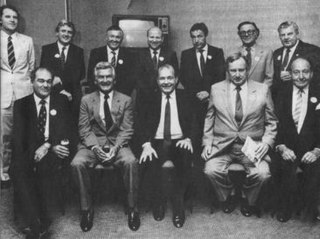
ATCO Ltd., operating as the ATCO Group, is a publicly-traded Canadian engineering, logistics and energy holding company based in Calgary, Alberta. ATCO's subsidiaries include electric utilities, natural gas production and distribution companies, and construction companies.
Puget Sound Energy, Inc. (PSE) is an energy utility company based in the U.S. state of Washington that provides electrical power and natural gas to the Puget Sound region. The utility serves electricity to more than 1.2 million customers in Island, King, Kitsap, Kittitas, Pierce, Skagit, Thurston, and Whatcom counties, and provides natural gas to 877,000 customers in King, Kittitas, Lewis, Pierce, Snohomish and Thurston counties. The company's electric and natural gas service area spans 6,000 square miles (16,000 km2).
Western Power Corporation (WPC), owned by the Government of Western Australia, was Western Australia's major electricity supplier from 1995 until 2006.

WA Inc was the name for a set of public-private partnerships in Western Australia in the 1980s associated with the Western Australian Development Corporation, which became a political scandal. The state government, which was led for much of the period by premier Brian Burke, engaged in business dealings with several prominent businessmen, including Alan Bond, Laurie Connell, Dallas Dempster, John Roberts, and Warren Anderson. These dealings resulted in a loss of public money, estimated at a minimum of $600 million and the insolvency of several large corporations.
The State Electricity Commission of Western Australia was a Government of Western Australia owned and managed energy provider. It was constituted on 20 March 1946, purchasing the City of Perth Electricity and Gas Department.
Alinta Limited was an Australian energy infrastructure company. It has grown from a small, Western Australia–based gas distributor and retailer to the largest energy infrastructure company in Australia. It was bought in 2007 by a consortium including Singapore Power and various parties which include the now defunct Babcock & Brown funds.

Verve Energy was a Western Australian Government owned corporation responsible for operating the state's electricity generators on the state's South West Interconnected System (SWIS).

Synergy is a corporation owned by the Government of Western Australia. Synergy is Western Australia (WA)’s largest energy retailer and generator with more than one million industrial, commercial and residential customers, generating total annual revenue of more than $3.2 billion.
Western Power is a statutory corporation established by the Electricity Corporations Act 2005 (WA). It is owned by the State Government of Western Australia and is accountable to the Minister for Energy. It is responsible for building, maintaining and operating the electricity network within the South West Interconnected System (SWIS), the poles and wires or energy grid.

The Emu Downs Wind Farm is a 79.2 MW wind farm in Western Australia. It was a 50:50 joint development between Griffin Energy and Stanwell Corporation. The site is approximately 200 kilometres north of Perth, near Cervantes. Construction of the $180 million project commenced in November 2005, and the project was commissioned in October 2006.
Madison Gas and Electric Company (MGE) is the primary subsidiary of MGE Energy, Inc.. As a regulated utility, it primarily serves the Madison, Wisconsin metropolitan area with electricity, gas and green energy options.
The Australian Energy Market Operator (AEMO) performs an array of gas and electricity market, operational, development and planning functions. It manages the National Electricity Market (NEM), the Wholesale Electricity Market (WA) (WEM) and the Victorian gas transmission network. AEMO also facilitates electricity and gas full retail contestability, overseeing these retail markets in eastern and southern Australia. It is additionally responsible for national transmission planning for electricity and the establishment of a Short Term Trading Market (STTM) for gas.
David Charles Parker is an Australian former politician from Western Australia, serving as a minister in the Burke Ministry (1983–1988), then as Deputy Premier in the Dowding Ministry (1988–1990). He later served a jail term for perjury for evidence given to the WA Inc royal commission.

Parry Street is a street in Fremantle, Western Australia.

The Fremantle Gas and Coke Company was a Western Australian company based in Fremantle.
Kemerton Power Station is a power station 17 km northeast of Bunbury in Western Australia. It is located in an area known as the Kemerton Industrial Park. The location had been considered as being Kemerton, in the 1980s as a potential aluminium smelter location, but is now considered to be part of Wellesley. The consideration of the site as being appropriate as a power station site was being considered in the early 2000s.
Shell Energy Australia provides gas, electricity, environmental products and energy productivity services to commercial and industrial customers.
Western Australia, like other Australian states and high-income countries, is a heavy energy user by global standards.







